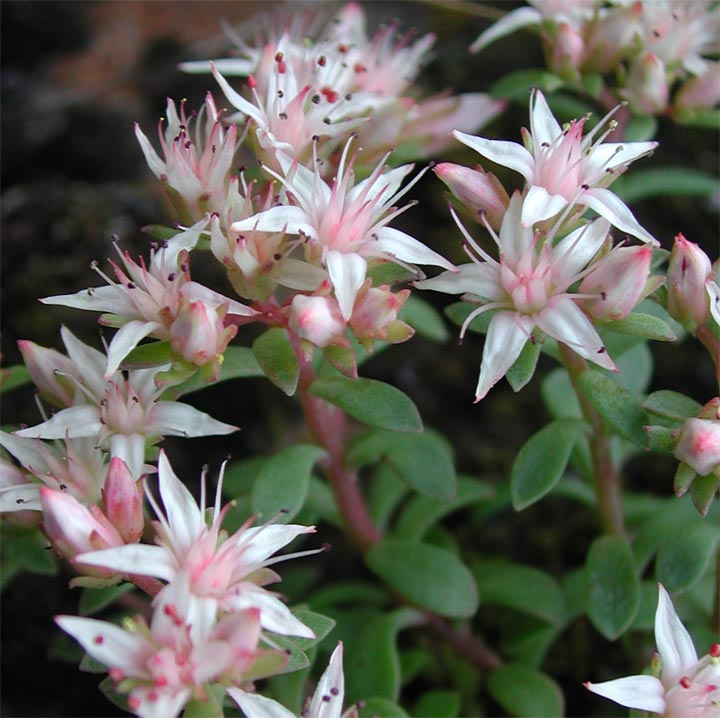Sedum
|
Family: Crassulaceae |
Herbs, annual, biennial, or perennial, rarely subshrubs, not viviparous, 0.2-10 dm, glabrous or hairy. Stems erect, ascending, procumbent, or creeping, usually much-branched, sometimes succulent, usually hardly secondarily thickened, base sometimes slightly woody. Leaves deciduous or persistent, rarely rosulate, sometimes forming dense rosettes, usually alternate, sometimes opposite or in whorls of 3-5[-6], ± alike, petiolate or sessile, not connate basally; blade linear to orbiculate or spatulate, terete, semiterete, or subterete, rarely laminar, 0.1-8 cm, usually ± succulent, base spurred or not, margins entire, (with 1 abaxial apical hydathode); veins not conspicuous. Inflorescences terminal or axillary cymes (sometimes compound, cincinnate, less often simple). Pedicels present or absent. Flowers erect, (3-)5-8[-12]-merous; sepals distinct and spurred or slightly connate basally, (green), equal or strongly unequal; petals spreading or erect at anthesis, usually distinct or slightly connate basally, [connate for 1/3-2/3 their lengths], yellow, white, pink, purple, or reddish, sometimes red-lineolate (often with reddish keel and adaxial subapical appendage), margins entire; calyx and corolla not circumscissile; nectaries oblong, square, transversely oblong, reniform, or spatulate; stamens 2 times as many as sepals, rarely as many as sepals; filaments of epipetalous stamens usually adnate basally, filaments of antipetalous stamens usually distinct, rarely connate basally; pistils erect, slightly connate basally to almost distinct, (usually sessile with broad base); styles equaling or shorter than ovary. Fruits erect or spreading. Seeds ovoid to ellipsoid, (usually ca. 1 mm), reticulate or reticulate-papillose. 2n = 4-ca. 640. Many genera of Crassulaceae currently recognized are derived from Sedum, the largest genus in the family. Molecular studies by H. ´t Hart (1995), R. C. H. J. van Ham and ´t Hart (1998), ´t Hart et al. (1999), S. Mayuzumi and H. Ohba (2004), and M. E. Mort et al. (2001) have formed the basis for recognizing segregate genera when the nomenclatural, biogeographic, and morphological data also have been available. Such data are still lacking for many other groups, and these are retained in Sedum pending further study. R. T. Clausen (1975) provided the most comprehensive treatment to date of native and naturalized Sedum in North America.
PLANT: Annuals to shrubs; ours small glabrous to papillose perennial herbs. STEMS: in ours dying to base after flowering, the next year's shoots at first making rosettes at base. LEAVES: in ours alternate, narrowly attached, linear to obovate, entire. INFLORESCENCE: in ours a terminal cyme of several one-sided branches. FLOWERS: perfect, in ours subsessile, 5-merous, open; sepals equal or unequal; petals in ours white or yellow, separate, spreading from near base; stamens usually, as in ours, twice as many as sepals. FOLLICLES: erect or spreading, usually, as in ours, many-seeded. NOTES: Ca. 500 spp. mostly in rocky places, widespread mostly in temperate N Hemisphere. (Latin: sedere = to sit - the usual derivation; but Berger gave sedare = to calm or mitigate, because of the healing properties of some). Clausen, R. T. 1975. Sedum of North America north of the Mexican Plateau. Ithaca: Cornell Univ. Press; Uhl, C. H. 1985. Rhodora 87:381-423. REFERENCES: Moran, Reid. 1994. Bixaceae. J. Ariz. - Nev. Acad. Sci. Volume 27, 190-194. Fls mostly 4-5(-9)-merous; pet distinct or united only at the very base; stamens usually twice as many as the pet, the antepetalous ones usually adnate at base to the pet; carpels distinct or nearly so, tapering to the short, stout subulate style; fr follicular; seeds numerous; succulent herbs or half-shrubs with thick or terete, alternate, opposite, or whorled lvs and small to middle-sized, yellow or white to anthocyanic fls. In addition to the following native and intr. spp., a number of spp. are cultivated and may escape locally. 300, mainly N. Temp. Gleason, Henry A. & Cronquist, Arthur J. 1991. Manual of vascular plants of northeastern United States and adjacent Canada. lxxv + 910 pp. ©The New York Botanical Garden. All rights reserved. Used by permission. |

